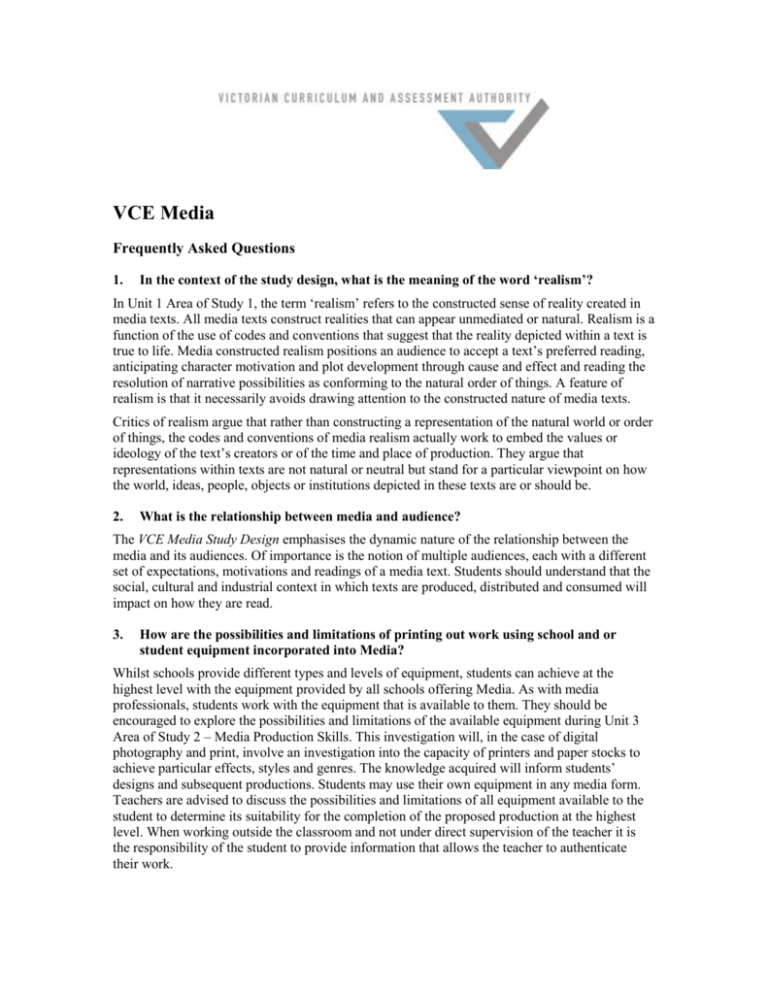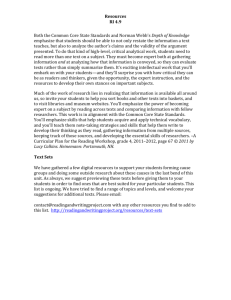VCE Media
advertisement

VCE Media Frequently Asked Questions 1. In the context of the study design, what is the meaning of the word ‘realism’? In Unit 1 Area of Study 1, the term ‘realism’ refers to the constructed sense of reality created in media texts. All media texts construct realities that can appear unmediated or natural. Realism is a function of the use of codes and conventions that suggest that the reality depicted within a text is true to life. Media constructed realism positions an audience to accept a text’s preferred reading, anticipating character motivation and plot development through cause and effect and reading the resolution of narrative possibilities as conforming to the natural order of things. A feature of realism is that it necessarily avoids drawing attention to the constructed nature of media texts. Critics of realism argue that rather than constructing a representation of the natural world or order of things, the codes and conventions of media realism actually work to embed the values or ideology of the text’s creators or of the time and place of production. They argue that representations within texts are not natural or neutral but stand for a particular viewpoint on how the world, ideas, people, objects or institutions depicted in these texts are or should be. 2. What is the relationship between media and audience? The VCE Media Study Design emphasises the dynamic nature of the relationship between the media and its audiences. Of importance is the notion of multiple audiences, each with a different set of expectations, motivations and readings of a media text. Students should understand that the social, cultural and industrial context in which texts are produced, distributed and consumed will impact on how they are read. 3. How are the possibilities and limitations of printing out work using school and or student equipment incorporated into Media? Whilst schools provide different types and levels of equipment, students can achieve at the highest level with the equipment provided by all schools offering Media. As with media professionals, students work with the equipment that is available to them. They should be encouraged to explore the possibilities and limitations of the available equipment during Unit 3 Area of Study 2 – Media Production Skills. This investigation will, in the case of digital photography and print, involve an investigation into the capacity of printers and paper stocks to achieve particular effects, styles and genres. The knowledge acquired will inform students’ designs and subsequent productions. Students may use their own equipment in any media form. Teachers are advised to discuss the possibilities and limitations of all equipment available to the student to determine its suitability for the completion of the proposed production at the highest level. When working outside the classroom and not under direct supervision of the teacher it is the responsibility of the student to provide information that allows the teacher to authenticate their work. VCE MEDIA 4. Why has the Media Production Design Plan changed to emphasise research? In Unit 3 Area of Study 3, the term ‘method of research’ refers to the approaches students choose in the investigative stages of their Media Production Design Plan. Students may need guidance in targeting their research using media industry practices such as sourcing and recording influences or techniques and referencing these through effective notation that concisely explains how or why the research was relevant in the development of the design. These practices will vary according to the media form in which students work and the style, genre, intention and audience/s for which the design is created. 5. For audio production, could a student make a music CD with a number of songs adding up to the minute length? In Unit 4 Area of Study 1, the intention of the scope of task for the media form radio or audio production is to produce a work that employs the conventions of radio or audio productions such as radio plays, documentaries, soundscapes, podcasts or segments that may form part of a longer radio or audio production. In Media, the terms, codes, conventions and styles have a particular meaning associated with productions that establish, develop and resolve a story or idea using more than music alone. Students may produce music that contributes to a radio or audio production but the music should support a story or idea rather than be the focus of the product itself. 6. There seems an imbalance in terms of digital film requirements compared with other medium choices. The scope of task for the Media production is described at length but the key knowledge and skills and assessment criteria allow for great diversity in the complexity in terms of the design, production and realisation of a product for an identified audience/s and purpose. Thus a production such as a highly complex music video may be as challenging to produce as a simple narrative of greater length. In print a student choosing to produce, for example, a hand drawn zine or a highly complex eight-page advertising booklet involving a fashion shoot with complex costume, makeup and lighting effects, extensive post production manipulation, layout and high gloss bled to the edge printing can satisfy the criteria for assessment at the highest level as can a student producing a local newspaper with a greater number of pages. During the design process teachers guide students in their planning decisions to scope a task appropriate to their audience and intention that is balanced with the degree of complexity envisaged in the proposed production. Students should plan a product that they can achieve at the highest level rather than one that is at the maximum designated scope of task. Key skills include operation of equipment and the management of the production process. Longer is not necessarily better, such works may not score as highly as those of shorter length that are more complex or more skilfully executed. 7. What ‘society’ is being referred to in the area of study on society’s values? Is this one value, Australian or contemporary values? Can students consider the changes to beliefs over a period of time? In Unit 4 Area of Study 2 – Media texts and society’s values, the nature of the values and the society in which they are represented are not specified. Schools may choose to study values and texts from any society they consider appropriate. These may include Australian values or those from other societies, contemporary values or those evident in or developing across time or place. VCAA November 2011 2 VCE MEDIA 8. What number is meant by ‘a range of texts’ when considering ‘society’s values’? The number of texts selected for study will depend on the approach to this outcome. Students undertake the study of an identified significant idea, social attitude or discourse located in a range of media texts to critically analyse its representation in the media. Media texts are studied to support the analysis rather than as the focus of this area of study. Teachers may choose to study texts from within or across media forms such as films, television drama and current affairs may be studied alongside advertisements from the society and time in which these texts were created. 9. In Unit 4 Area of Study 2, would it be appropriate to use the original version of a text and compare it with a modern remake and look up how the same story/film has changed due to the change in values? Comparison and contrast is a sound approach to a discussion and analysis of society’s values as represented in media texts. In this approach other texts such as advertisements or news reports from the time and place of creation of the both texts could be used to support the analysis. 10. What is media influence? In Unit 4 Area of Study 3, students explore the complexity of the relationship between the media, its audiences and the wider community in terms of the nature and extent of the media’s influence. Students will study communication theories and models to support a presentation and analysis of arguments about the nature and extent of media influence, comparing and contrasting them in terms of how they conceptualise notions of audience and in their application to media forms and texts. Students will build on this understanding in an analysis of the rationale for, mechanisms of and arguments about the regulation of the media. Students are encouraged to analyse what each theory and viewpoint reveals in terms of the relationships between the media and its audiences within the context of society. VCAA November 2011 3









